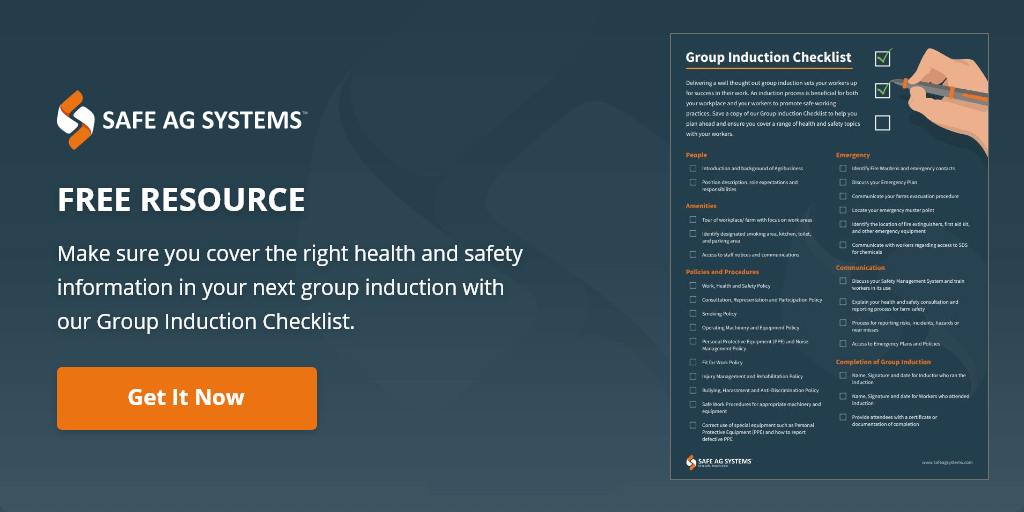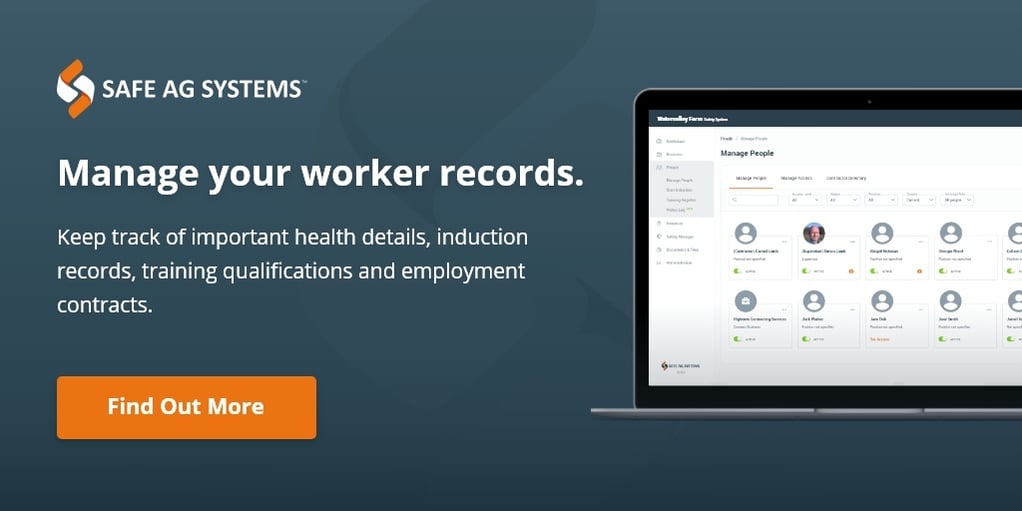Make sure to cover the right health and safety information in your next group induction with our free checklist.
Your health and safety induction program should assist new, returning and possibly existing agricultural workers as they settle into your business and their new role, whether that’s short or long term. An induction process is beneficial for both your workplace and your worker to promote safe working practices, as well as playing an integral role in the success of your safety management system. Your induction process also applies to contractors and it is your way of promoting workplace behaviour that is in line with you WHS practices.
What is a group induction?
A health and safety induction should focus on just that, health and safety. Your induction process should focus on your workplace policies and culture, safe work procedures and emergency procedures as well.
When you have a few people starting all at the same time, such as pickers or other seasonal workers, doing a group induction makes a lot of sense. Utilising software for group inductions means you can share the same information to many people at the same time, so they are time and cost effective for an agricultural business, especially if they are doing similar work.
You need to provide workers and contractors with adequate training and induction so they can safely do their job. This obligation falls under your duty of care as an employer, by ensuring you are providing a safe workplace. If your workers do not have an understanding around your WHS policies and procedures, how can they keep themselves and your workplace safe?
Your group induction process provides additional benefits other than just meeting your legal obligations, it saves you time and assists with keeping your workers up to date as well as reducing the risk of incidents.
Best practice for WHS Group Inductions in farming.
Delivering a well thought out group induction process sets your workers up for success in their work.
Creating a plan
We suggest creating a plan or schedule prior to your new workers starting. Your plan should outline what topics you will need to cover and training that is required.
Since you are being proactive and organising your group induction processes ahead of time, you will allow your new workers to be productively contributing to your agribusiness as quickly as possible.
Creating your checklist
- Look to address expectations for the role
- Review the job description and where that role fits in with your agribusiness
- Take your new workers on a tour around the workplace, show them where amenities and key points are, and spend extra time on their work areas
Health and Safety information you should cover:
- Your agribusiness policies and expectations (WHS Policy, code of conduct, manual handling, chemical safety, fit for work, etc.)
- Relevant safe work practices and procedures
- Workplace health and safety legislative requirements
- Explain how your workers can access emergency information (first aid and emergency contacts, emergency evacuation and assembly points, fire alarms and firefighting equipment, medical emergency, etc.)
- Correct use of special equipment such as Personal Protective Equipment (PPE), how to report defective PPE
- Identified risks and hazards in the workplace as well as how a worker should report an incident or new hazard
- Your health and safety consultation and reporting process for farm safety
- Communication requirements including use and maintenance of implemented safety system
Health and safety group induction checklist
Safe Ag Systems has a Group Induction Checklist template you can utilise. Our checklist covers a range of health and safety topics from people and introducing your agribusiness, through to emergencies, policies and procedures. Save a copy and refer to it as you plan your next group induction.
Other things to consider:
- Depending on the length of the induction, allow for breaks. This could be as simple as a morning tea break, allowing your workers to digest the information and not be overwhelmed.
- You may have previously read about the importance of a Buddy System during a workers’ first week in a new role. Whilst this may not be applicable to many agricultural businesses, an induction buddy is someone who new workers can go to as an informal source of information
- Provide your worker with a certificate or documentation of completion
- Request Feedback on your induction process
Group Inductions are complete. What do I need to record?
When you have a group arriving on your farm it is important that they complete your induction process before they move on to something else. You need to ensure an inductor is present and all attendees understand the information, whatever their background. This may mean providing the group induction in other languages, or perhaps using images and pictures, or showing a video of a process. You could even ask a few questions of attendees to confirm they have understood the information presented. It is important to get the names of all attendees and get them to sign against their name as evidence they have attended. You need to keep a record of all health and safety training.
Topics: Safety Management System
Disclaimer: Content on this website may be of relevance to users outside of Australia, but content links and examples are specific to Australia. Please check with your local authority for your country and industry requirements.













